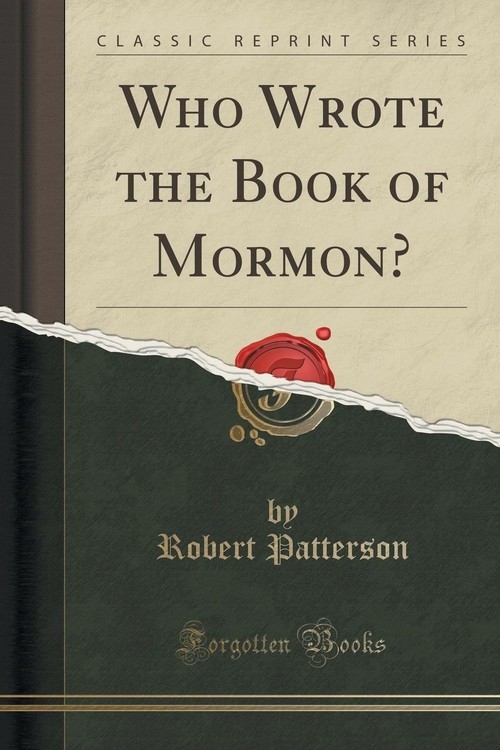Who Wrote the Book of Mormon? (Classic Reprint)
Patterson Robert
Who Wrote the Book of Mormon? (Classic Reprint)
Patterson Robert
- Wydawnictwo: FB &c Ltd
- EAN: 9781332212057
- Ilość stron: 22
- Format: 15.2x22.9cm
- Oprawa: Miękka
Niedostępna
Opis: Who Wrote the Book of Mormon? (Classic Reprint) - Patterson Robert
Excerpt from Who Wrote the Book of Mormon
The conviction has become almost universal, except among Mormons themselves, that the "Book of Mormon" was founded upon Rev. Solomon Spaulding's romance, entitled "Manuscript Found." It is eminently fitting, therefore, that a history of Washington County, Pa., in one of whose villages Spaulding spent his last years, and where, after a checkered life, his wearied body found its resting-place, should contain at least a brief notice of the man whose pen has been the guiltless cause of one of the most remarkable delusions the world has ever witnessed.
Solomon Spaulding was born in Ashford, Conn., in 1761; graduated at Dartmouth College, N. H., in 785; entered the ministry of the Congregational Church; preached for three or four years, and then, on account of impaired health, relinquished the sacred office, removed to Cherry Valley, N. Y., and engaged- in mercantile business; in a few years failed in this enterprise, and in 1809 removed to Conneaut (formerly I New Salem), Ashtabula Co., Ohio, where he engaged in building a forge. This business also proved unsuccessful, and he became involved in debt. Residing at Conneaut for three years, his attention was arrested by the numerous Indian mounds and fortifications in- its vicinity, and being a man of literary tastes, and particularly fond of history, he conceived the project of writing a romance which would purport to account for the presence of the mound-builders on this continent, and to narrate their history. This employment beguiled the tedious hours of his enforced leisure, and when, the romance approached completion, the idea suggested itself that its publication, by the profits arising from its sale, might enable him to discharge his debts.
The time of Spaulding's residence at Conneaut was chiefly spent in the preparation of this historical romance, and as the work progressed the author was accustomed to inform his neighbors, who would gladly assemble to hear each new installment read. In this small frontier settlement, where books were few and mail facilities very limited, each additional portion of the romance was awaited with the same interest with which the reader of the modern magazine, looks for the number that will contain a fresh installment of the popular serial of the day. The characters and the incidents became subjects of general discussion, the outlines of the narrative were deeply impressed on the minds of the hearers, and the names of the prominent personages grew "familiar as household words."
At last, in 1812, with the fond hope that his daydreams might be converted into something more substantial, Spaulding removed to Pittsburgh, at that time a small but rapidly-growing city (its population in 1810 was 4768, with 767 houses in all), and took his manuscript to the printing-office of Mr. Patterson (father of the present writer) to see if arrangements could be made for its publication. For some reason, probably lack of funds on the part of the author and doubts of success on that of the publisher, it was not given to the world. In 1814, Mr. Spaulding removed to Amity, Washington Co., Pa., where he died Oct.20, 1816. His widow removed to the home of her brother, W. H. Sabine, Esq., at Onondaga Valley, N. Y.
Thus far all accounts agree. What became of Mr. Spaulding's manuscript is not so clear. That it was not published is matter for profound regret. How many bitter tears had remained unshed, how many homes undesolated, how many hearts unbroken had the printing in 1812 of Spaulding's prose epic rendered forever impossible the imposture under which, eighteen years afterwards, with many incongruous additions, it saw the light!
In this discussion there are manifestly but two points to be considered. The first is to establish the fact that the historical portions of the Book of Mormon are certainly derived from Spaulding's "Manuscript Found;" and the second to show, if practicabl
Szczegóły: Who Wrote the Book of Mormon? (Classic Reprint) - Patterson Robert
Nazwa: Who Wrote the Book of Mormon? (Classic Reprint)
Autor: Patterson Robert
Wydawnictwo: FB &c Ltd
Kod paskowy: 9781332212057
Języki: angielski
Ilość stron: 22
Format: 15.2x22.9cm
Oprawa: Miękka




























